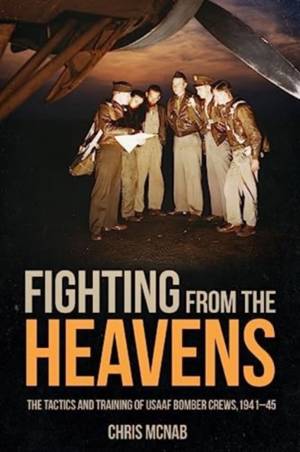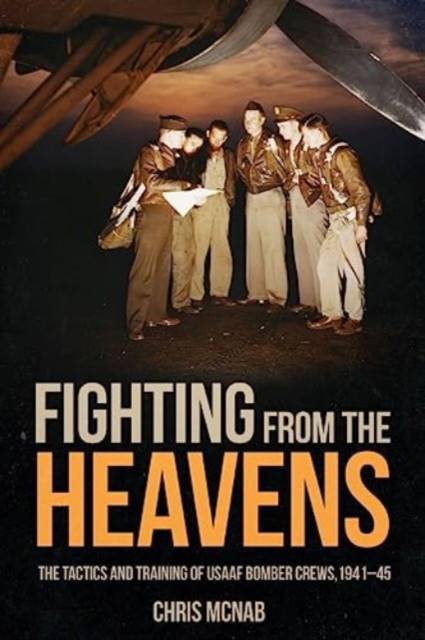
- Afhalen na 1 uur in een winkel met voorraad
- Gratis thuislevering in België vanaf € 30
- Ruim aanbod met 7 miljoen producten
- Afhalen na 1 uur in een winkel met voorraad
- Gratis thuislevering in België vanaf € 30
- Ruim aanbod met 7 miljoen producten
Zoeken
Fighting from the Heavens
Tactics and Training of Usaaf Bomber Crews, 1941-45
Chris McNab
Hardcover | Engels
€ 34,95
+ 69 punten
Omschrijving
"...expands our knowledge of bomber operations, making it a most welcome addition to the aerial combat literature." -- The Journal of America's Military Past
During World War II, the US Army Air Forces (USAAF) projected American military might across distances and with destructive force unimaginable just a decade previously. The B-17s and B-24s of the US Eighth Air Force, for example, turned much of Germany's infrastructure to twisted steel and burnt rubble between 1943 and 1945. B-29 Superfortresses unleashed conventional raids on Japan of even greater area destruction than that created by the atomic bomb attacks (also delivered by USAAF crews). Beyond heavy strategic bombing, US bombers performed a multitude of other tactical roles, including hunting Axis submarines, bombing enemy shipping, low-level runs against precision targets, and providing heavy air support to advancing infantry and armor. While the US bombers dealt out violence, however, they were also prey to a terrifying spectrum of antiaircraft threats, and by the end of the war 88,119 US airmen had died in service.
Bomber crews were a world unto themselves, composed of pilots, co-pilots, engineers, navigators, wireless operators, gunners, and bombardiers. And each aircraft type had its own unique characteristics and capabilities, from twin-engine B-25 Mitchells designed for strafing and skip-bombing to the four-engine workhorses of the strategic bombing campaign: the B-17 Flying Fortress, B-24 Liberator, and B-29 Superfortress. Fighting from the Heavens: Tactics and Training of USAAF Bomber Crews, 1941-45 presents an invaluable collection of material from US wartime manuals, including doctrinal, training, technical, aircraft-specific, and position-specific publications. Through these manuals, the reader gains an insider's insight into the demands of US bomber warfare, including long-distance navigation, gun-turret operation, formation flying, bomber start-up procedures, and bomb aiming.
During World War II, the US Army Air Forces (USAAF) projected American military might across distances and with destructive force unimaginable just a decade previously. The B-17s and B-24s of the US Eighth Air Force, for example, turned much of Germany's infrastructure to twisted steel and burnt rubble between 1943 and 1945. B-29 Superfortresses unleashed conventional raids on Japan of even greater area destruction than that created by the atomic bomb attacks (also delivered by USAAF crews). Beyond heavy strategic bombing, US bombers performed a multitude of other tactical roles, including hunting Axis submarines, bombing enemy shipping, low-level runs against precision targets, and providing heavy air support to advancing infantry and armor. While the US bombers dealt out violence, however, they were also prey to a terrifying spectrum of antiaircraft threats, and by the end of the war 88,119 US airmen had died in service.
Bomber crews were a world unto themselves, composed of pilots, co-pilots, engineers, navigators, wireless operators, gunners, and bombardiers. And each aircraft type had its own unique characteristics and capabilities, from twin-engine B-25 Mitchells designed for strafing and skip-bombing to the four-engine workhorses of the strategic bombing campaign: the B-17 Flying Fortress, B-24 Liberator, and B-29 Superfortress. Fighting from the Heavens: Tactics and Training of USAAF Bomber Crews, 1941-45 presents an invaluable collection of material from US wartime manuals, including doctrinal, training, technical, aircraft-specific, and position-specific publications. Through these manuals, the reader gains an insider's insight into the demands of US bomber warfare, including long-distance navigation, gun-turret operation, formation flying, bomber start-up procedures, and bomb aiming.
Specificaties
Betrokkenen
- Auteur(s):
- Uitgeverij:
Inhoud
- Aantal bladzijden:
- 208
- Taal:
- Engels
Eigenschappen
- Productcode (EAN):
- 9781636243825
- Verschijningsdatum:
- 15/12/2023
- Uitvoering:
- Hardcover
- Formaat:
- Genaaid
- Afmetingen:
- 150 mm x 231 mm
- Gewicht:
- 458 g

Alleen bij Standaard Boekhandel
+ 69 punten op je klantenkaart van Standaard Boekhandel
Beoordelingen
We publiceren alleen reviews die voldoen aan de voorwaarden voor reviews. Bekijk onze voorwaarden voor reviews.











